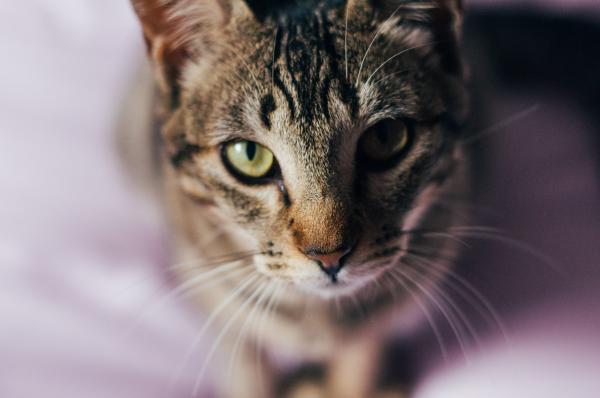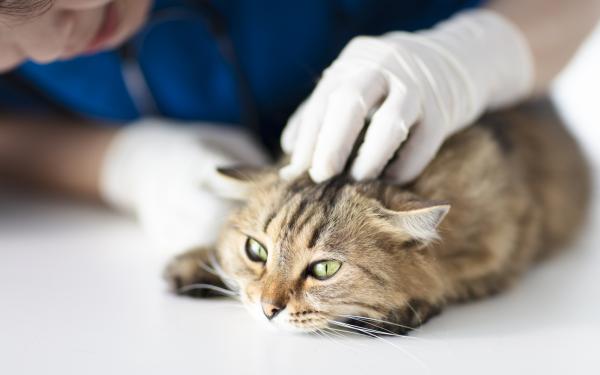
Keratitis in cats is a chronic, inflammatory disease of the cornea, in a cat's eye. This illness is common in cats that are four years of age and younger. If you think your cat may be suffering from keratitis, you've come to the right place for information!
In this AnimalWised article we're going to explain everything you need to know about keratitis in cats, including what it is, the types, causes, common symptoms and treatment.
What is keratitis in cats?
Keratitis, also known as cloud in the eye due to the appearance that the affected eye takes on, is a pathology where there is inflammation in the cornea, the clear outer layer of the eye. This occurs when a type of white blood cell called eosinophls invades the cornea, giving the surface of the eye a pink, white or chalky appearance and bringing health risks to our cat.
This health issue is most common in cats of 4 years of age or younger. It has also been observed in shorthairs, longhairs and purebred cats. You may also be interested in our article about the most common cat eye diseases.

Types of keratitis in cats
There are several types of keratitis in cats. Although they all vary in certain details, they can all cause blindness and need immediate veterinary assistance. We'll highlight the following types of keratitis in cats:
Eosinophilic keratitis
Also known as proliferative keratoconjunctivitis, this is when there is an infiltration of blood vessels and cells in the form of a whitish-pink plaque in the cornea. It is believed to be due to a chronic and immune-mediated inflammatory reaction, but the stimulus that triggers it is unknown. It only occurs in cats and is more common in specimens of over seven years of age.
Ulcerative keratitis
This is when there is an ulcer or wound in the cornea, relatively common in cats, since it usually appears from injuries such as scratches. These ulcers can be of greater or lesser depth, depending on the layers they affect. Treatment will depend on its characteristics.
Infectious keratitis
In this case, inflammation of the cornea occurs due to infection. It is usually triggered from a wound or ulcer on the cornea that is contaminated by pathogens. In the case of cats, these are usually herpesviruses, causing the so-called herpetic keratitis, which causes typical dendritic ulcers. This is more common in kittens. If the infection is caused by bacteria, the keratitis will be bacterial. For their part, fungal infections are the origin of fungal or fungal keratitis, something rare in cats.
Nevertheless, just like any other type of keratitis, only your veterinarian will be able to properly diagnose and treat your cat according to what type of keratitis they have and the cause.
Causes of keratitis in cats
As we've previously mentioned, keratitis is defined as the inflammation of the cornea. It presents a type of cloud that we can distinguish over the eye and that is responsible for losing its transparency. It can occur in one or both eyes. In fact, it's common for it to begin in one eye and end up affecting or infecting the other. Any cat can get keratitis, regardless of breed, age or sex. Nevertheless, there seem to be certain breeds more prone than others.
What causes keratitis in cats?
The cause of keratitis in cats isn't completely clear. For some types of keratitis, the cause is an infection, in other cases it's due to an injury, and in others it is unknown. With that being said, most cases are caused by trauma to the eye.
Another interesting point to make is that viral infection, especially feline herpesvirus, has often been associated with keratitis. Nevertheless, to truly know the cause of your cat's illness, your veterinarian will need to run the necessary examinations to determine the illness and cause.
You may also be interested in our article about why your cat has so many eye boogers.
Symptoms of keratitis in cats
Symptoms of keratitis in cats can be identified quickly, as they are quite visible. We highlight the following:
- Cloudy eye.
- Eye closed or ajar.
- Red eye, with irritated conjunctiva.
- Intense and continuous tearing
- Eye discharge.
- Strabismus (squinting).
- Photophobia (intolerance to light).
- Protrusion of the third eyelid, located in the inner corner of the eye and can extend over the eye in an attempt to protect it.
- Discomfort, itching and pain that lead the cat to try to scratch their eye.
If your cat is experiencing any of these clinical symptoms, it's important to take them to the veterinarian as soon as possible. Treating this health issue early on is vital so your cat can regain their eye health and not lose vision, which is what will happen if a professional does not intervene.
You may also be interested in our article about why your cat has red eyes.

Treatment of keratitis in cats
When taking your cat to a veterinarian, make sure they have experience in ophthalmology, as the diagnosis will require a cytological examination. Once diagnosed, your veterinarian will determine what treatment will be best for your cat's condition. This could be an antibiotic eye drops, when faced with a bacterial eye infection.
The medication is administered directly to the affected eye. They are usually long treatments and even lifelong in cases where there is an immune problem, as it will be a chronic disease, controllable, but not curable. This means that, as caregivers, we must commit ourselves to the welfare of our cat.
Ultimately, if it is impossible to directly administer the treatment into their eye, oral or injectable treatment may be considered. On the other hand, it is necessary to maintain a veterinary follow-up, since relapses can occur.
You may also be interested in watching our video below on how to clean your cats eyes with chamomile.

This article is purely informative. AnimalWised does not have the authority to prescribe any veterinary treatment or create a diagnosis. We invite you to take your pet to the veterinarian if they are suffering from any condition or pain.
If you want to read similar articles to Keratitis in Cats - Types, Symptoms, Treatment, we recommend you visit our Eye problems category.
- González, Sarmiento, Udiz and Morales. (2018). Feline eosinophilic conjunctivitis associated with feline herpesvirus type 1 . Small Animal Veterinary Clinic. Vol. 38, No. 4.
- Morales and de León. (2012). Review of corneal alterations in felines . Veterinary Portal .